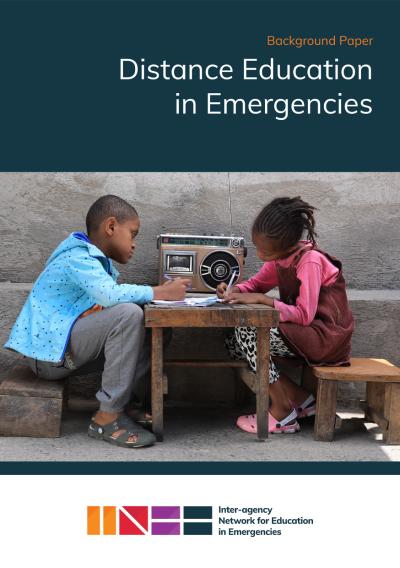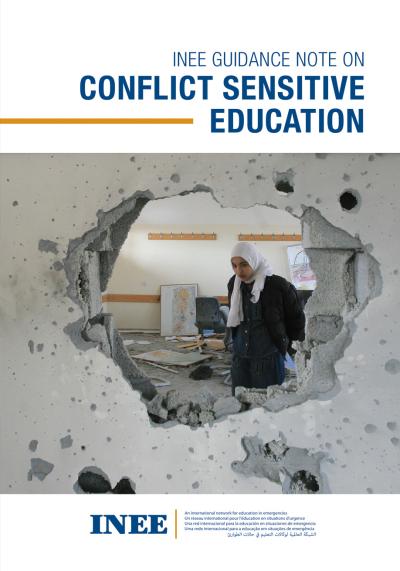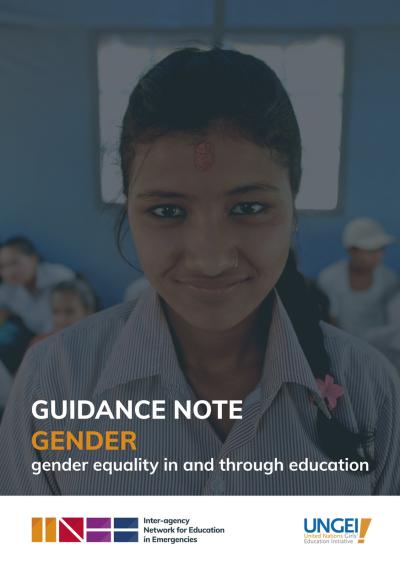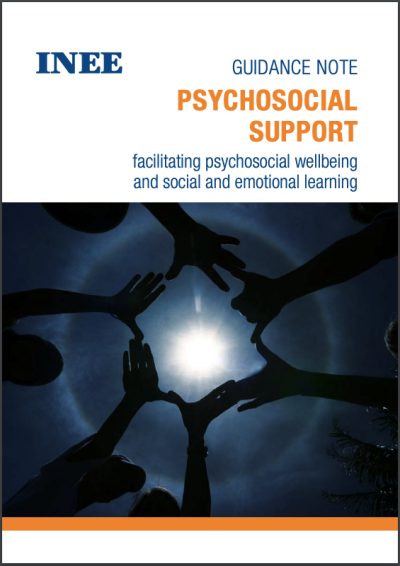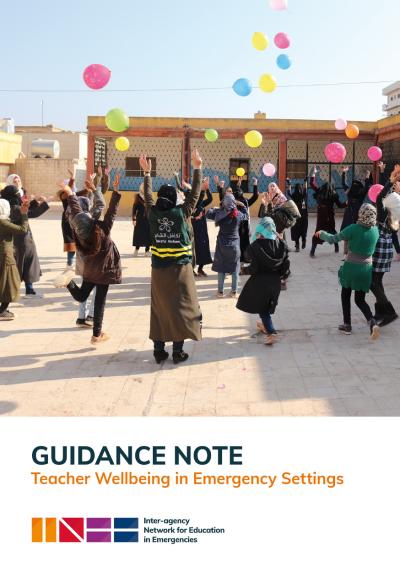Standard 11: Curricula
The curricula used to provide formal and non-formal education are culturally, socially, and linguistically relevant, and appropriate to the context and learner’s needs.
On this page
1. Appropriate curriculum: Ensure that the curriculum is appropriate for learners’ context, age, developmental level, capacities, and needs.
See Guidance Notes:
2. Core competencies and skills: Ensure that the curriculum, textbooks, and supplementary learning materials cover the core competencies of basic education.
See Guidance Notes:
3. Mental health and psychosocial support, wellbeing, and protection: Ensure that the curriculum addresses learners’ social, emotional, and protection needs.
See Guidance Notes:
4. Curriculum for diversity: Ensure that the curriculum recognizes diversity and is responsive to the factors causing marginalization.
See Guidance Notes:
5. Curriculum review and development: Recognize and support the responsibility of education authorities to lead any development, review, or adaptation of the formal curriculum.
See Guidance Notes:
6. Sourcing learning resources: Promptly provide sufficient, locally-sourced teaching and learning resources.
See Guidance Notes:
The curriculum should be age appropriate. This means that it is compatible with learners’ reading levels and that the texts, examples, and illustrations align with their developmental levels. Developmental level usually refers to the cognitive, but it also includes life experience and psychosocial and physical development. The curriculum should reflect the learners’ day-to-day environment, promote gender equity and inclusiveness of persons with disabilities, and avoid prejudicing or frightening learners. It also should give learners a constructive understanding of the key issues of climate change and environmental sustainability.
Learners of the same age will have different developmental levels. Even with an age-appropriate curriculum, this means that the materials and approaches need to be differentiated. This need may increase when classes change during emergencies. For example, they may increase in size due to newly-arrived refugee or displaced learners or serve multi-age learners. Teachers will require support to adapt their teaching to the learners’ varying needs and levels. If different education delivery models are to be used, such as accelerated or non-formal education, an analysis of the curriculum will need to be undertaken to identify key concepts for each developmental level.
Differentiated learning: This is a teaching approach that involves offering several different learning experiences. It proactively addresses students’ varied needs to maximize learning opportunities for each student in the classroom. It requires teachers to be flexible in their approach and to adjust the curriculum and presentation of information for learners of different abilities
Learners who are being introduced to a new language will need additional support. In situations where learners have crossed borders and are to be integrated immediately into the host country education system, this support will have to be part of the classroom practice or provided in afterschool sessions. If a transition period is planned, education stakeholders can implement language support or bridging programs to help learners gain familiarity with the new language. Meanwhile, teachers from the same community can teach them in their mother tongue. Bilingual or multilingual education approaches, wherein learners’ mother tongue is taught at the same time they are introduced to a second language, can help to improve learners’ performance in the second language and in other subjects. Research and evidence has found that young children learn most effectively in a language they understand. To ensure that children develop strong foundational literacy and numeracy skills, their early education should be in their mother tongue as much as possible.
Education authorities and other education actors should identify the core competencies and skills that need to be taught to different age groups before developing any learning materials. National authorities may have established competency frameworks for age and level of education. International frameworks also exist. During emergencies, it will be necessary to determine whether the frameworks include the competencies and skills needed to build and support essential, crisis-specific needs.
Early childhood is a crucial time for helping learners build a strong foundation of competence and skill development. These foundational competencies provide a base on which learners will develop additional skills as they grow older and advance through leveled programs. Initial core competencies include functional literacy and numeracy, and social and emotional skills. However, to address the healthy development of the whole child, early childhood development may focus on a broader range of skills. Subject knowledge may be expanded and deepened across learning levels. This will help provide children and young people with the skills they need to build healthy relationships with peers and others, including communication skills. In an emergency context, it may be necessary to focus on additional knowledge, competencies, and skills. Depending on the context, this could include health and hygiene, sexual and reproductive health and rights, HIV/AIDs and other diseases, climate change, and human rights education, such as citizenship and democracy, peacebuilding, and humanitarian law.
Because there is an increased need to protect learners during emergencies and through to recovery, less time may be spent on instruction. This may create the need to prioritize competencies and skills by age and learning level. A prioritization process may be coordinated by national education authorities and supported by the relevant inter-agency coordination mechanism, or be addressed at the organization and program level. If a full curriculum is inappropriate or impossible to implement, the relevant decision-makers will need to determine whether programs should focus on specific competencies and skills. Core competencies and skills that are part of the curriculum design may need to be scaffolded so the initial focus can be on learners’ wellbeing and essential skills. Scaffolding competencies and skills, including SEL, will depend on the crisis. For example, during a health crisis or pandemic, the focus will be on providing targeted health and safety content and skills-development opportunities. These may be part of an essential package that also includes MHPSS, SEL, and foundational literacy and numeracy.
Stakeholders should make every effort to coordinate their adaptations across learning levels, from ECD through tertiary and across formal and non-formal programs. This will ensure that learners have options and opportunities to progress in their learning during an emergency and through to recovery.
The key skills learners need are determined by the context and can include:
- Social and emotional skills: These are the skills needed to question, solve problems, collaborate, make decisions, and communicate with empathy, creativity, and self-awareness.
- DRR and life-saving skills and behaviors: These skills include gender-specific protection, education on landmines and unexploded ordnance, and safe practices during a pandemic.
- Creative and sports skills: These skills include music, dance, drama, and the visual arts, and various individual and team sports and games.
TVET courses and programs should offer different types of courses and different levels of certification that reflect current and future market needs, as affected by the crisis. Gender stereotyping should be avoided so that all learners receive information and advice on the courses available. TVET learners will also need certain competencies and social and emotional skills to succeed when later employed. TVET teaching and learning processes can emphasize these skills. This may include providing practical experiences, such as work placements and apprenticeships, that enable learners to apply new skills. TVET course options and recruitment should reflect an awareness of potential gender stereotyping so it can be avoided (for more guidance, see Minimum Economic Recovery Standards, Employment Standards and Enterprise and Market Systems Development Standards).
The curriculum should address learners’ wellbeing and need for MHPSS and protection. Teachers and other education personnel need clear guidance on teaching approaches and classroom activities that will help them provide MHPSS. Education authorities and technical experts will need to establish learning objectives and benchmarks that outline what learners need to know to build their SEL and other aspects of wellbeing, along with knowledge and behaviors that enable them to protect themselves and seek assistance when needed. Those learning objectives may require a specific curriculum or teaching and learning resources. They may also require orientation and support for teachers and other education personnel on a variety of teaching methods. This may include contextualized play-based learning, which can help learners build confidence and self-esteem and support their wellbeing (see the EiE Glossary for a definition of play).
Teachers need to be able to recognize signs of distress in learners and know how to respond. This includes knowing when to refer learners to specialized services, where this is feasible. If these services are not available, education authorities and supporting organizations will need to provide guidance for teachers and schools on how to offer support, within reason. Teachers should not be expected, for example, to provide counselling services they are not qualified for, as this may cause more distress (for more guidance, see Supporting Integrated Child Protection and Education Programming in Humanitarian Action; Minimum Standards for Child Protection, Standard 23).
It can be difficult for teachers to follow a curriculum that does not meet their learners’ needs, which can affect their wellbeing. It is important for education authorities and other education actors to review all curricula to ensure that they promote teachers’ and learners’ mental health and psychosocial wellbeing, including developing social and emotional skills. Curricula, textbooks, and other materials should address the potential stigma and discrimination related to MHPSS (for more guidance, see the INEE Guidance Note on Teacher Wellbeing in Emergency Settings).
It is important to consider diversity while developing and carrying out all educational activities at every stage of the emergency and through to recovery. Diversity relates to gender, sexuality, age, ethnicity, nationality, race, religion, language, displacement status, abilities and disabilities, and socioeconomic background. Diversity should be reflected in the content, examples, and illustrations of the learning materials used. Teachers should adopt inclusive approaches that recognize the success and achievements of all learners. Education stakeholders should develop formal and non-formal curricula in a way that respects local and indigenous ways of producing knowledge. The curricula should include learning materials and activities that reflect the knowledge, skills, values, and experiences of local and indigenous communities. The learning environment should also reflect the diversity of the community, with people of different ages, genders, abilities, and ethnicities in displays or notice boards. Teachers and other education personnel should model and promote respect for diversity and all people in the learning environment.
Teachers and other education personnel should be given training that makes them aware of how the curriculum can contribute to exclusion, along with strategies to promote inclusivity, respect, and nonviolence (for more guidance, see INEE Guidance Note on Gender).
Developing the curriculum is a sovereign issue, and adaptations or changes should come from a country’s education authorities. If there is a need to develop learning materials, the curriculum from the country of origin or other EiE curriculum approved by the host country can be used. Partner organizations, such as UN agencies or NGOs, can offer guidance on curricula for EiE settings and help teachers create additional learning materials, as needed. This applies to both content and language. It should be clearly understood by education authorities and their partners that this material has been added, and that it is not an adaptation of the host curriculum but a temporary measure. Teachers can use stories and play activities to introduce new subject areas, such as climate change and human rights education, and should be supported in so doing. The curriculum for young children should provide plenty of play opportunities, both free and structured, that include hands-on experience and collaboration with other children.
In crisis-affected contexts, any curriculum reform should follow crisis and conflict sensitive principles, especially when examining a curriculum for any potential issues of inequity, prejudice, or bias. The reform should be gradual, participatory, and informed by a crisis analysis (for more guidance, see INEE Guidance Note on Conflict Sensitive Education).
At the beginning of an emergency, education stakeholders should assess what resources are available to support learning and learners. For refugees, this may include materials from their country of origin, which will help them transition to the host country curriculum. For higher education, this may include locally constructed knowledge, research methods that prioritize local ways of knowing, and research activities that comply with national or sub-national standards for ethics approval and research licenses. Stakeholders should evaluate materials to ensure that they are accessible to learners in terms of print size, page layout, illustrations, etc., and that they include a balance between input and tasks. It is important to analyze these materials from a perspective of inclusion and to ensure that there is no gender, cultural, or religious bias. The materials should be approved by the education authorities.
Learning materials should be distributed through existing systems, such as those used for supplies or exam papers. Partner agencies can also help distribute materials along with other emergency items, such as food or blankets. When deciding how to distribute the materials during a health emergency, stakeholders should consider issues of health and safety.
Indicators
| INEE Domain | INEE Standard | Indicator/Program Requirements | Clarification | Numerator | Denominator | Target | Disaggregation | Source of Indicator | Source of Data | Available Tool | Crisis Phase | |
| Teaching and Learning | Curricula (T&L Std 1) Culturally, socially and linguistically relevant curricula are used to provide formal and non-formal education, appropriate to the particular context and needs of learners. |
3.1 Pupil-textbook ratio | Number of students | Number of textbooks | 1:1 | Level of education Gender Ethnicity Mother tongue Wealth quintile Disability Displacement status As relevant |
New | School administrative data | Right to Education Monitoring Guide | All stages | ||
| 3.2 Percentage of targeted learning spaces whose learning materials meet minimum quality standards | Curricula, textbooks, and other learning materials should be inclusive, conflict-sensitive, gender-transformative, promote SEL and PSS, etc. | Number of targeted learning spaces where learning materials meet minimum standards of quality | Number of targeted learning spaces | 100% | Formal vs non-formal | New | Learning material analysis | Tool required | All stages | |||
| 3.3 Percentage of students in the right grade for their age | Number of students at a grade level appropriate to within one year of their age | Number students | 100% | Level of education Gender Ethnicity Mother tongue Wealth quintile Disability Displacement status As relevant |
New | School administrative data | No tool required; INEE MS and indicator definitions sufficient | All stages | ||||
| 3.4 Percentage of targeted crisis-affected children and youth benefiting from relevant skills development (SEL / PSS / risk awareness / environmental education / conflict prevention) | Number of targeted crisis-affected children and youth benefiting from relevant skills development (SEL/PSS/risk awareness/ environmental education/conflict prevention) | Number of identified crisis-affected children and youth needing relevant skills development (SEL/PSS/risk awareness/ environmental education/conflict prevention) | 100% | Level of education Gender Ethnicity Mother tongue Wealth quintile Disability Displacement status As relevant |
New | Learning outcome measures | Tool required | All stages | ||||
| 3.5 Percentage of targeted learning spaces utilizing curriculum aligned to national standards | In formal settings, the national curriculum should be used. In non-formal settings, the curriculum should be appropriate and compatible with the national curriculum. | Number of targeted learning spaces utilizing curriculum aligned to national standards |
Number of targeted learning spaces |
100% | Formal vs non-formal | New | Program documentation | Tool required | All stages | |||
| Training, Professional Development and Support (T&L Std 2) Teachers and other education personnel receive periodic, relevant and structured training according to needs and circumstances. |
3.6 Percentage of teachers who show increased understanding of and practice Teacher’s Role & Well-being; Child Protection, Well-being; Inclusion; Pedagogy; Curriculum & Planning; and Subject Knowledge | Number of teachers who show increased understanding of and practice Teacher’s Role & Well-being; Child Protection, Well-being; Inclusion; Pedagogy; Curriculum & Planning; and Subject Knowledge | Number of teachers | 100% | Gender | TiCC | Classroom observation, teacher survey | World Bank's open-source classroom observation tool Teach | All stages | |||
| 3.7 Teacher satisfaction level with TPD activity/activities they have participated in | Number of teachers satisfied with TPD activities they have participated in | Number of teachers | 100% | Gender | TiCC | Teacher survey | Tool required | All stages | ||||
| 3.8 Percentage of teachers who report feeling confident in their ability to teach effectively | Number of teachers who report feeling confident in their ability to teach effectively | Number of teachers | 100% | Gender | TiCC | Teacher survey | Tool required | All stages | ||||
| 3.9 Percentage of teachers and other education personnel benefiting from professional development according to assessed needs | Number of teachers and other education personnel benefiting from professional development according to assessed needs | Number of teachers | 100% | Gender | New | Program administrative data | Tool required | All stages | ||||
| 3.10 Degree of teacher professional development recognition and/or certification | Number of teachers whose TPD is recognized or certified | Number of teachers | 100% | Gender | New | Program documentation | Tool required | All stages | ||||
| Instruction & Learning Processes (T&L Std 3) Instruction and learning processes are learner-centred, participatory and inclusive. |
3.11 Percentage of teachers whose training included methods for how to engage all students equally and in a participatory way | Number of teachers whose training included methods in how to engage all students equally and in participatory way | Number of teachers | 100% | Gender | New | Teacher survey | Tool required | All stages | |||
| 3.12 Appropriateness of teaching methods to the age, developmental level, language, culture, capacities, and needs of learners | Scale 1-5 (1 = low, 5 = high) | 5 | NA | New | Classroom observation | World Bank's open-source classroom observation tool Teach | All stages | |||||
| 3.13 Percentage of teachers who use structures or routines to manage classroom interactions more effectively | Number of teachers who demonsrate effective use of structures or routines for managing classroom interactions | Number of teachers | 100% | Gender | New | Classroom observation | World Bank's open-source classroom observation tool Teach | All stages | ||||
| 3.14 Frequency of parental engagement in communications that inform them of learning content and teaching methods | Number of parent-teacher engagement sessions | Per year | To be defined by program | NA | New | program documentation | No tool required; INEE MS and indicator definitions sufficient | All stages | ||||
| Assessment of Learning Outcomes (T&L Std 4) Appropriate methods are used to evaluate and validate learning outcomes. |
3.15 Percentage of teachers capable of assessing learning progress | Number of teachers who are trained in and use continuous student formative learning assessments | Number of teachers | 100% | Gender | New | Classroom observation | World Bank's open-source classroom observation tool Teach | All stages | |||
| 3.16 Degree of use of accreditation, certification, and recognition | Measures whether students' learning achievements are formally recognized through accreditation, certification, or some other form of recognition. This is particularly relevant when completing levels, such as primary or secondary | Scale 1-5 (1 = low, 5 = high) | 5 | NA | New | Program documentation | No tool required; INEE MS and indicator definitions sufficient | All stages | ||||
| 3.17 Learning assessments are available in first languages | Number of languages available for assessments | Number of first languages | 100% | NA | New | program documentation | No tool required; INEE MS and indicator definitions sufficient | All stages | ||||




